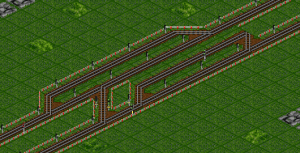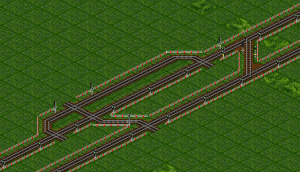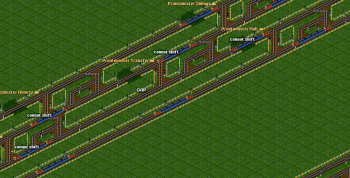Shift Mainlines
From #openttdcoop wiki
| It has been suggested that this article or section be merged with Shift Mainline. (Discuss) |
The concept of Shift MainLines is to have trains automatically shift from one end of the ML to the other end if there is space. This means trains automatically try to pack towards one end of the ML without using any complicated mergers. This is mainly effective with poorly accelerating trains as they do not have to stop and take their long acceletaion.
How shifting works
We shift trains by giving them the access to the neighbouring line - with a detection whether there is a train (priority), and additionally we add penalties to the current line, so that trains want to shift elsewhere - to the less penalized line.
Original Shifter
This is how the first shifter was designed. It consists of a choice to the neighbouring line supported by a priority, a penalty and in case the 2way entry signal gets red just when a train starts heading towards it (prio gets suddenly red), there also has to be an alternative path around it so ML flow is not harmed. This however is still a large issue as the once stopped trains have to accelerate from the stop.
| PSG 149 | Download: Public Server Game 149 Final / Archive entry for this game |
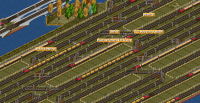
|
The old shifter array used in psg149. |
Fail-Safe Shifters
The goal of this type of shifter is to make trains shift the lines at full speed and never stop. This is reached by using the so-called fail-safe system, where once the train reaches the 2way entry signal, it is always green - even if the last bit of the priority suddenly gets red. These shifters were introduced by this blog article: Fail-safe shifters
| PSG 172 | Download: Public Server Game 172 Final / Archive entry for this game |

|
Fail-safe shifters instantly replaced the older design by their safe reliability. |
Shift gaps
SML is extremely easy to build but it has some downsides, it can create gaps because trains just randomly join the ML. Some gaps cannot be filled in order to keep proper priorities and not slow the ML down.
Timed SML
The ultimate solution to SML is to use fail-safe shifters and then time the train joining, so that no shift gaps are created, as demonstrated in pzg13.
| PZG 13 | Download: Pro Zone Game 13 Final / Archive entry for this game |
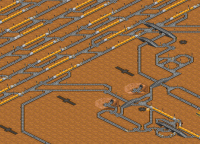
|
Trains carefully timed by the complicated joining mechanisms, resulting in precise gaps between trains and set places where trains could join the ML. |
